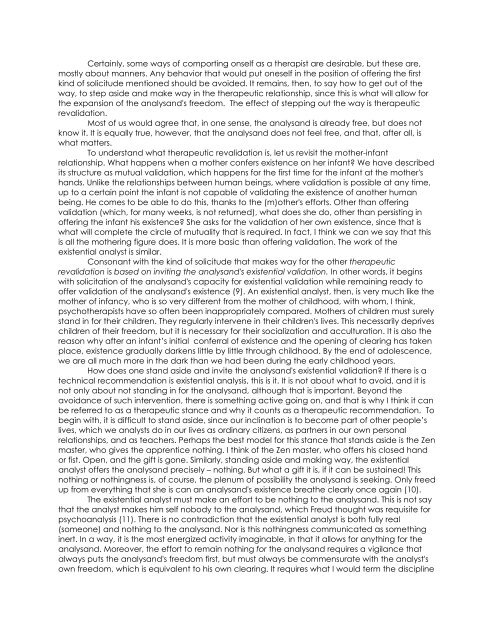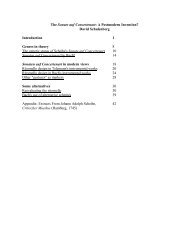SEVEN PAPERS ON EXISTENTIAL ANALYSIS ... - Wagner College
SEVEN PAPERS ON EXISTENTIAL ANALYSIS ... - Wagner College
SEVEN PAPERS ON EXISTENTIAL ANALYSIS ... - Wagner College
Create successful ePaper yourself
Turn your PDF publications into a flip-book with our unique Google optimized e-Paper software.
Certainly, some ways of comporting onself as a therapist are desirable, but these are,<br />
mostly about manners. Any behavior that would put oneself in the position of offering the first<br />
kind of solicitude mentioned should be avoided. It remains, then, to say how to get out of the<br />
way, to step aside and make way in the therapeutic relationship, since this is what will allow for<br />
the expansion of the analysand's freedom. The effect of stepping out the way is therapeutic<br />
revalidation.<br />
Most of us would agree that, in one sense, the analysand is already free, but does not<br />
know it. It is equally true, however, that the analysand does not feel free, and that, after all, is<br />
what matters.<br />
To understand what therapeutic revalidation is, let us revisit the mother-infant<br />
relationship. What happens when a mother confers existence on her infant? We have described<br />
its structure as mutual validation, which happens for the first time for the infant at the mother's<br />
hands. Unlike the relationships between human beings, where validation is possible at any time,<br />
up to a certain point the infant is not capable of validating the existence of another human<br />
being. He comes to be able to do this, thanks to the (m)other's efforts. Other than offering<br />
validation (which, for many weeks, is not returned), what does she do, other than persisting in<br />
offering the infant his existence? She asks for the validation of her own existence, since that is<br />
what will complete the circle of mutuality that is required. In fact, I think we can we say that this<br />
is all the mothering figure does. It is more basic than offering validation. The work of the<br />
existential analyst is similar.<br />
Consonant with the kind of solicitude that makes way for the other therapeutic<br />
revalidation is based on inviting the analysand's existential validation. In other words, it begins<br />
with solicitation of the analysand's capacity for existential validation while remaining ready to<br />
offer validation of the analysand's existence (9). An existential analyst, then, is very much like the<br />
mother of infancy, who is so very different from the mother of childhood, with whom, I think,<br />
psychotherapists have so often been inappropriately compared. Mothers of children must surely<br />
stand in for their children. They regularly intervene in their children's lives. This necessarily deprives<br />
children of their freedom, but it is necessary for their socialization and acculturation. It is also the<br />
reason why after an infant’s initial conferral of existence and the opening of clearing has taken<br />
place, existence gradually darkens little by little through childhood. By the end of adolescence,<br />
we are all much more in the dark than we had been during the early childhood years.<br />
How does one stand aside and invite the analysand's existential validation? If there is a<br />
technical recommendation is existential analysis, this is it. It is not about what to avoid, and it is<br />
not only about not standing in for the analysand, although that is important. Beyond the<br />
avoidance of such intervention, there is something active going on, and that is why I think it can<br />
be referred to as a therapeutic stance and why it counts as a therapeutic recommendation. To<br />
begin with, it is difficult to stand aside, since our inclination is to become part of other people’s<br />
lives, which we analysts do in our lives as ordinary citizens, as partners in our own personal<br />
relationships, and as teachers. Perhaps the best model for this stance that stands aside is the Zen<br />
master, who gives the apprentice nothing. I think of the Zen master, who offers his closed hand<br />
or fist. Open, and the gift is gone. Similarly, standing aside and making way, the existential<br />
analyst offers the analysand precisely – nothing. But what a gift it is, if it can be sustained! This<br />
nothing or nothingness is, of course, the plenum of possibility the analysand is seeking. Only freed<br />
up from everything that she is can an analysand's existence breathe clearly once again (10).<br />
The existential analyst must make an effort to be nothing to the analysand. This is not say<br />
that the analyst makes him self nobody to the analysand, which Freud thought was requisite for<br />
psychoanalysis (11). There is no contradiction that the existential analyst is both fully real<br />
(someone) and nothing to the analysand. Nor is this nothingness communicated as something<br />
inert. In a way, it is the most energized activity imaginable, in that it allows for anything for the<br />
analysand. Moreover, the effort to remain nothing for the analysand requires a vigilance that<br />
always puts the analysand's freedom first, but must always be commensurate with the analyst's<br />
own freedom, which is equivalent to his own clearing. It requires what I would term the discipline















